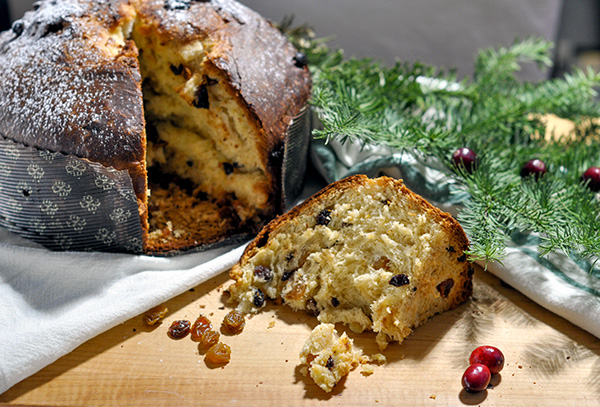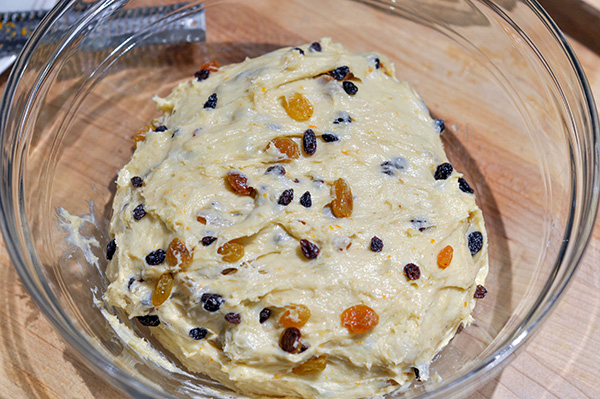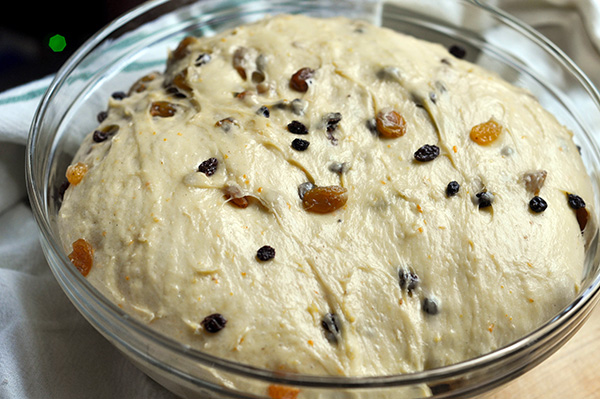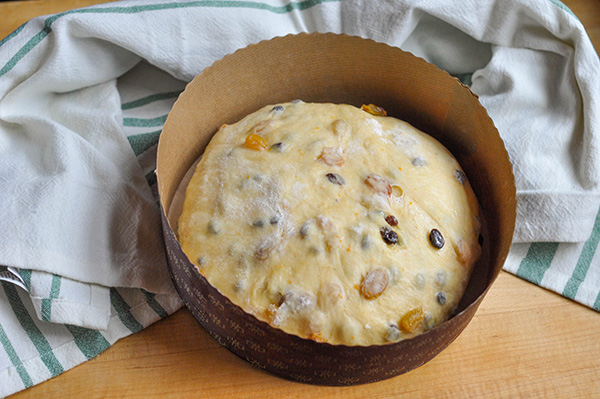Christmas Panettone
Christmas seems to be a holiday made just for food bloggers. As my feed fills with gorgeous pictures of sugar, spice and every cookie imaginable, I'm thinking of something bigger. Apparently I'm a glutton for punishment and felt the need to really go for it this season. So this weekend I decided to try my hand at the famous... or rather infamous Jim Lehey recipe for Christmas Panettone.
I say infamous because this recipe takes about 29 hours to make. Yes... I said 29 hours. I planned my weekend around this Panettone. I started this on Friday morning to ensure we were eating it by Saturday evening. Sounds ridiculous, but a freshly baked pannetone was, I would say worth it. The interior was soft and inviting, flavored with run raisins, currents, and orange zest. It was heavenly and perfect for a snowy weekend. It takes commitment and dedication, but I'm sure your family would totally enjoy the end product.
I don't want to make this sound intimidating, because honestly the steps are not hard to do. It just takes a lot of time and planning. To begin the process, I soaked a cup of raisins and currents in hot water and rum for 8 hours. I did this Friday morning so that they were ready by Friday evening when it was time to make the dough. Once they were all good and soaked, I started the dough around 7pm on Friday. The dough is an enriched dough made of flour, eggs, honey, citrus zest and yeast. The ingredients get mixed in a stand mixer for about 10-12 minutes till it reaches the windowpane stage, which is then the dough can be stretched apart and not break, but create a thin membrane thats thin enough to see through. This is how you know enough gluten has been created in the kneading process. Once its ready, take the bowl out of the mixer and fold in the soaked raisins, currents and melted butter. Ohhh, yesss. The original recipe also called for chopped candied orange peel, but I honestly couldn't find it anywhere and did't have time to order it online, so I added more orange zest to help make up for it. Once it was all mixed in, it was time to let the dough rise...for 12-15 hours. The slow rise process allows the dough to develop a richer flavor, which is why I made this in the evening- to allow it enough time to rise overnight. The dough gets formed into a loose ball (the dough is very soft and wet, so its ok if it won't for a tight ball), covered in plastic wrap and placed in a cold oven overnight to rise.
Fast forward 12 hours later, the dough rose and it was time to turn it out onto a floured surface. Dust with a bit more flour on top and fold the sides of the dough in on itself to form a ball with a tight skin on the underside. Turn the dough over and place into your pannetone mold. I bought my paper pan at Sur La Table for $1 each. Cover your dough with a damp cloth and let it rise for 3-5 hours in a warm spot. Again? Yep. At this point my mom walked in and was immediately disappointed to have to wait another 5 hours before she could taste it. But wait we must. This is when I left it out on my counter and went out to do the grocery shopping for the week. There's no need to babysit it, just let it do its thing!
After this rise... it was finally, finally time to bake. So using a small serrated knife, I cut an "X" on top of the bread and place a 1 tbsp knob of butter in the center. I placed the pannetone on a sheet tray and sent it into bake for about an hour. Also make sure your oven rack is near the bottom to allow the pannetone enough room in your oven to rise, as it'll puff up as it bakes. The pannetone will get pretty dark when its done. According to the recipe this is how it should be. It is done, when a skewer is placed in the center and comes out slightly wet. However, once its done baking, it's still not ready to eat. I know, this is turning into some kind of Italian Christmas torture. But you need to place 2 skewers through the bottom of the pannetone and hang it upside down in a stock pot to cool for at least an hour. I read that the reason for this is to allow the melted butter to distribute evenly through out the cake. Either way, I followed the rules and after 27 hours of prepping, rising, baking and waiting, it was finally ready to be devoured. Yay!
The cake was soft and feathery on the inside and crisp on the outside, with plenty of raisins and currents to add that burst of sweetness. The cake itself was not overly sweet, just slightly scented with citrus flavor. It was heavenly. Needless to say we ate it all in about a day, and it really does taste better the day its baked. It should keep for a couple of days if properly wrapped in plastic wrap, foil and placed in a plastic bag. But once its done, It'll be hard not to eat it all in one sitting.
This recipe may take some time, but for fresh pannetone, it's worth not buying a $40 boxed cake. At least in my opinion. I will try to make another recipe that doesn't take as much time for those who don't have 27-29 hours to kill. But for now. Happy Holidays! And follow me on Instagram and twitter for more yummy recipes!!
Christmas Panettone
*Adapted from The Jim Lehey Recipe from Gourmet Magazine
INGREDIENTS
- 1 cup golden raisins
- 1/2 cup currents
- 2 tablespoons light rum
- 2 tablespoons hot water
- 3¾ cups all-purpose flour
- ⅔ cup granulated sugar
- ½ teaspoon active dry yeast
- ½ teaspoon salt
- zest of 1 lemon
- zest of 1 navel orange
- ½ tbsp vanilla bean paste
- 3 eggs, at room temperature
- ⅔ cup tepid water
- 1 tablespoon honey
- 10½ tablespoons unsalted butter, well softened
- 1 tablespoon unsalted butter, melted
- 1 tablespoon unsalted butter, chilled
Other
- Panettone molds (6×4½-inch) – purchased at Sur La Table
- 12-inch metal or wooden skewers
Method
- In a small bowl, combine the raisins with the rum and 2 tablespoons of hot water. Allow to soak at room temperature, stirring occasionally, until the raisins are plump and most of the liquid has been absorbed, at least 8 hours or overnight.
- In a stand mixer fitted with a paddle attachment, mix together the flour, sugar, yeast, salt, citrus zest and vanilla bean paste on low speed until combined. In a medium bowl, whisk together the eggs, tepid water and honey. With the mixer on low speed, pour the egg mixture into the flour mixture. Increase the speed to medium-low and mix until all of the ingredients are combined. Add the softened butter, 1 tablespoon at a time, mixing until incorporated before adding more. Increase the speed to medium-high and beat until the dough is smooth and elastic, about 8 minutes.
- Drain the raisins, discard the soaking liquid, and stir together 1 tablespoon of melted butter with wooden spoon.
- Place the dough in a large bowl, cover with plastic wrap, and let rise in a cold oven with the door closed until it has nearly tripled in volume, 12 to 15 hours.
- Sprinkle the dough lightly with flour and scrape out onto a lightly floured surface. Sprinkle a bit more flour onto the dough, then fold the edges of the dough in towards the center, forming a loose ball, and place, seam-side down, into the panettone mold. Cover with a damp kitchen towel and let rise in a draft-free place at warm room temperature until the dough is just above the top of the mold, 3 to 5 hours.
- Preheat oven to 370 degrees F.
- Place the dough-filled panettone mold on a baking sheet. Use a very sharp serrated knife to score an “X” across the entire surface of the dough. Place the 1 tablespoon chilled butter in the center of the X and bake until a wooden skewer inserted into the center comes out slightly moist but not wet, 60 to 75 minutes (the panettone will be very dark).
- Remove from the oven and pierce 12-inch metal or wooden skewers all the way through the panettone (including the paper) 4 inches apart and 1 inch from the bottom so the skewers are parallel. Hang the panettone upside down over a large stockpot and cool completely before cutting. To store the panettone, wrap tightly in plastic wrap, then either place in a resealable plastic bag, or wrap again in foil. The bread will keep at room temperature for up to 1 week. (I have not tried freezing the bread, but I believe it would freeze well, wrapped in plastic, then foil, then placed in a resealable bag.)








